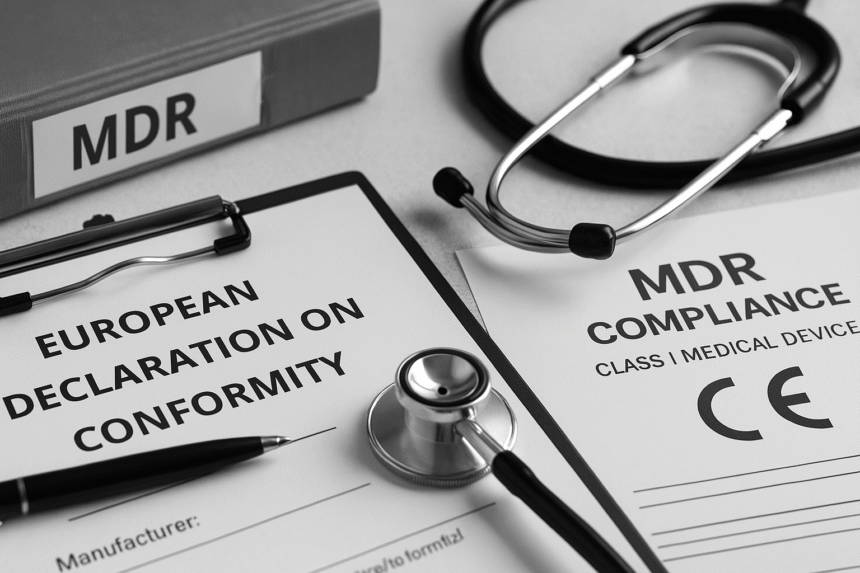The Proven Path to Passing the EU MDR Audit for Class I Devices: CE Marking and Medical Device Regulatory Compliance Made Simple
Executive Snapshot
EU MDR audit Class I devices requirements presented a critical obstacle for an Egyptian medical device exporter striving to maintain its foothold in the European market. The company, which specializes in low-risk Class I disposable medical devices, had been operating under the former MDD framework but now faced the full force of Regulation (EU) 2017/745 (EU MDR). With outdated technical documentation, no internal regulatory officer, and minimal experience navigating EU compliance language, the company was at serious risk of losing access to its most profitable distribution channels.
The stakes were high. Distributors began demanding updated Declarations of Conformity, MDR-aligned technical files, and documented medical device regulatory compliance procedures. Without meeting these new obligations, the exporter faced the suspension of EU shipments, contract terminations, and lasting reputational damage.
By initiating a structured approach that combined gap analysis, document restructuring, and strategic updates to supplier and distributor agreements, the company achieved full CE marking for low-risk medical devices under the EU MDR. Within just 21 business days, the exporter passed the audit conducted by a notified body—retaining its CE mark, preserving sales continuity, and even signing new agreements with European clients.
Background / The Situation: EU MDR Audit Class I Devices, CE Marking Challenges, and Medical Device Regulatory Compliance
The client, a mid-sized Egyptian manufacturer of Class I disposable medical devices such as surgical gloves and bandages, had been exporting to the European Union under the former Medical Devices Directive (MDD). However, with the full enforcement of the EU Medical Device Regulation (EU MDR) in 2021, the landscape changed dramatically. The company was notified by its EU distributors that continued sales would require updated declarations, revised technical documentation, and clear evidence of CE marking for low-risk medical devices under the new regulation.
Although the products fell under the Class I (low-risk) category, the EU MDR imposed significantly stricter requirements around documentation standards, post-market surveillance (PMS), and supplier control procedures. The manufacturer, lacking an internal regulatory affairs officer and possessing minimal familiarity with EU legal terminology, found itself at a crossroads. Shipments were placed on hold, distributor relationships were at risk, and revenue streams were under immediate threat.
To maintain market access and comply with medical device regulatory compliance expectations, the company urgently needed to prepare for and pass the EU MDR audit for Class I devices—a process that demanded both speed and precision. Without expert intervention, the business faced potential exclusion from the EU market and long-term reputational damage within the industry.
The Problem: Failing EU MDR Audit Class I Devices Requirements and Gaps in CE Marking and Regulatory Compliance
The exporter’s existing documentation fell far short of the updated expectations for medical device regulatory compliance under the EU MDR. Several critical gaps threatened their ability to retain CE marking for low-risk medical devices:
-
The Technical File lacked a clear rationale for risk classification in line with MDR Rule 1.
-
The Declaration of Conformity had not been updated since 2018, still referencing the outdated MDD framework.
-
No written post-market surveillance (PMS) procedure was in place—an essential requirement even for Class I devices.
-
Supplier agreement templates did not include the mandatory quality and traceability clauses required under MDR Annex I.
Without immediate intervention, the company risked:
-
Suspension of exports to key EU clients
-
Contract termination by European distributors
-
Long-term reputational damage in the medical device industry
The urgency to comply with the EU MDR audit for Class I devices, combined with the lack of in-house regulatory expertise, created a high-risk environment. A single oversight could result in the loss of EU market access, jeopardizing the company’s most profitable distribution channel.
The Strategy: How We Achieved EU MDR Audit Class I Devices Compliance with CE Marking and Regulatory Support
1. Legal & Regulatory Gap Analysis
We started by comparing the client’s current documents against MDR Annexes I, II, and III. Using a custom checklist, we flagged missing elements, such as:
- UDI (Unique Device Identifier) policy references
- Confirmation of risk classification according to Rule 1
- PMS and Vigilance Procedures
2. Updating Core Legal Documents
We rewrote and restructured several key documents:
- Technical File: Clearly categorized the product as Class I under Rule 1, with basic design description, labeling, and validation.
- Declaration of Conformity: Reissued to reflect MDR compliance, referencing Regulation (EU) 2017/745.
- PMS Procedure: Created a streamlined, proportional surveillance procedure tailored for low-risk Class I devices.
3. Distributor and Supplier Alignment
We reviewed and amended:
- Distribution Agreements: Added clauses requiring distributors to inform the manufacturer of complaints and incidents.
- Supplier Contracts: Added quality assurance and traceability requirements to align with MDR expectations.
4. Client Training and Mock Audit
We trained the quality manager and CEO on:
- Key audit questions
- Role of the PRRC (Person Responsible for Regulatory Compliance)
- Document presentation order
We then ran a mock audit session to simulate the interaction with the notified body.
The Outcome
Within 21 business days of the engagement, the Egyptian company passed the EU MDR Class I audit for devices. The notified body praised the clarity and simplicity of the documentation.
Results:
- CE Mark maintained without disruption
- New contract signed with a French distributor
- Internal SOPs improved to match EU best practices
Key Takeaways
- Even Class I devices need serious documentation under EU MDR. Don’t assume simplicity equals low risk.
- Tailored legal updates can dramatically reduce audit risk. You don’t need a full legal department—just the right guidance.
- Distributor contracts must be MDR-aligned. The EU compliance chain includes your partners.
Call-to-Action
If you’re a non-EU medical device manufacturer preparing for an MDR audit, start with your legal documents. Need a customized checklist or help reviewing your tech file? Book a consultation



Leave a Reply